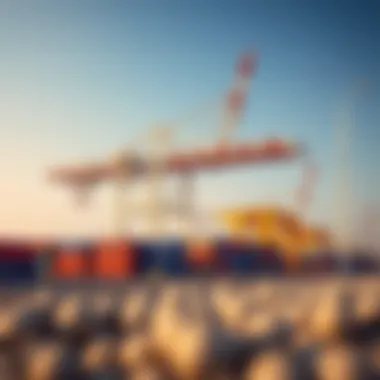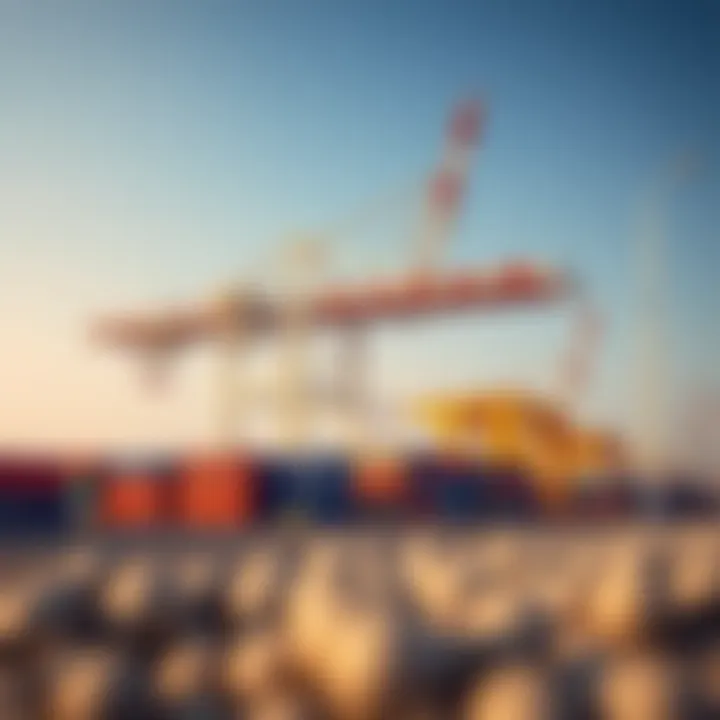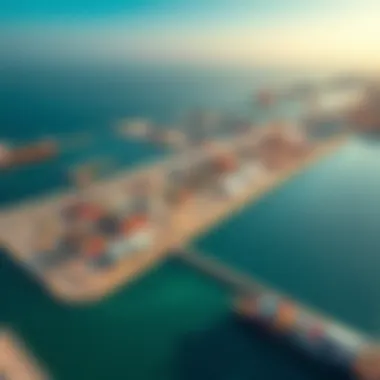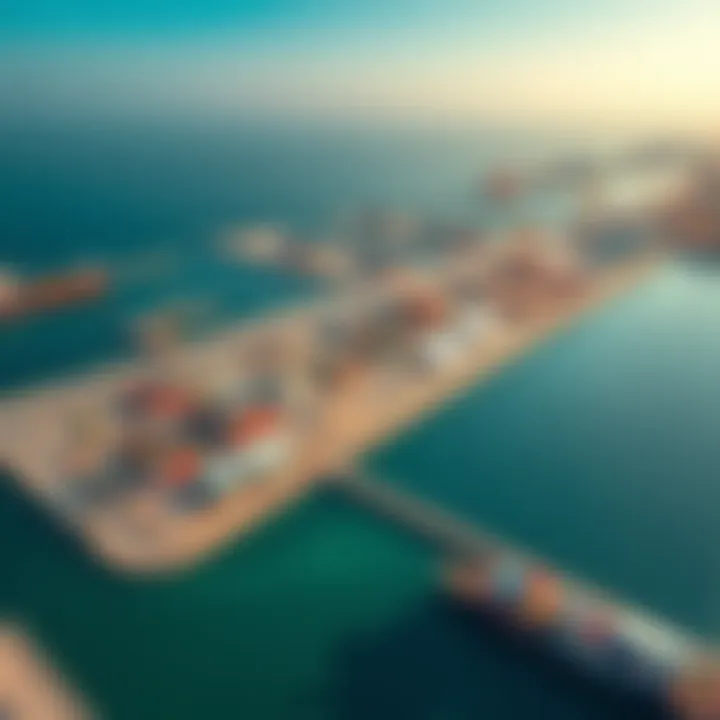Rashid Port: Central to Dubai's Maritime Future


Intro
In the vast and bustling maritime sector of Dubai, Rashid Port stands out as a critical component. It plays not just a role in trade, but also shapes the economic landscape significantly. This port, with its unique operational features and strategic position, is much more than a site for docking ships; it represents a nexus of commerce that connects Dubai with the rest of the globe.
Understanding Rashid Port means grasping its impact on trade flows, economic development, and investment opportunities in the region. For potential investors, stakeholders, and anyone interested in the dynamics of the maritime industry, comprehending the nuances of this port will be essential.
Through this discussion, we will unfold various elements surrounding the port's importance, from its historical roots to the latest market trends. Keep in mind, it’s not just about the ships; it’s about the broader implications for the local and global economy as well.
Historical Context of Rashid Port
Rashid Port, nestled along Dubai’s coastline, stands as a testament to the rapid evolution of maritime trade in the region. To understand the port's significance today, one must first look back at its origins and developmental journey. This historical context not only highlights how Rashid Port has risen to become a critical player in global trade but also showcases its role in shaping Dubai's economy and maritime landscape.
Origins and Development
The origins of Rashid Port can be traced to the late 1970s when Dubai was laying the foundational stones of its ambitious growth in trade and tourism. At that time, the demand for an advanced harbor was evident as traditional dhow trading began to give way to modern shipping systems. The goal was clear: evolve from a fishing village into a bustling commercial hub. This was no small task.
The port's development was marked by strategic planning and massive investment. In 1983, the port was officially inaugurated, signifying Dubai's entry into the global maritime arena. Its design was ahead of its time, accommodating a variety of vessels and cargo types, which was crucial given Dubai's trade-centric economy. Over the years, the port has undergone several expansions to keep pace with rising global trade demands and technological advancements.
Key Milestones
Understanding the key milestones in Rashid Port’s development provides insight into its strategic importance.
- 1983: The official opening of Rashid Port, which laid the groundwork for a new era in Dubai’s trading capability.
- 1990s: The port experienced a significant upgrade with new cargo handling systems that boosted efficiency, allowing for quicker turnaround times.
- 2001: Introduction of state-of-the-art container handling facilities facilitated the doubling of cargo capacity, which was pivotal as global shipping trends evolved.
- 2008: Peak in cargo handling operations with record throughput, reflecting Dubai's strategic location as a trade conduit between East and West.
- 2020: Launch of digital initiatives aimed at enhancing operational efficiency, showcasing Rashid Port's adaptability to modern trends.
These milestones are not just date markers; they symbolize resilience and innovation, critical for attracting investment and forming partnerships. The historical context is crucial when considering Rashid Port's role in Dubai’s broader maritime landscape—it’s more than just a harbor; it’s a cornerstone of economic prosperity and connectivity in the region.
Strategic Importance in Maritime Trade
Rashid Port plays a significant role in Dubai's standing as a global trade hub. It is not merely a docking station for ships; it serves as a critical juncture in the chain of maritime commerce, where goods flow in and out, impacting economies both locally and globally. The port's strategic location enhances its value, making it a linchpin in maritime trade. As economies continue to become increasingly interdependent, the need for efficient transport corridors such as that provided by Rashid Port becomes even more paramount.
Geographical Advantage
Positioned on the southeastern edge of the Arabian Peninsula, Rashid Port benefits from its geographical advantage. It sits directly along shipping routes that connect Europe, Asia, and Africa, which holds immense value for shipping companies. This location reduces transit times significantly, ensuring that cargo reaches its destination more quickly, which can translate into higher profitability for businesses.
- The proximity to major trade routes lowers shipping costs and minimizes the risk of delays.
- With a natural deep-water harbor, large vessels can dock with ease, which bolsters the efficiency of maritime operations.
- In addition to its physical advantages, the port has established a network with regional and international shipping lines. This connectivity further amplifies its reach across various markets.
Moreover, the port has tailored its facilities to accommodate various types of cargo, including containers, bulk goods, and automobiles, which opens pathways for diverse industries. Such flexibility is crucial for investors, as it offers multiple avenues for revenue generation in a dynamic trading environment, ultimately contributing to Dubai's ambition to be a global logistics center.
Connection to Global Trade Routes
Rashid Port serves as a gateway to vital global trade routes, playing a crucial role in connecting the Middle East with the rest of the world. It not only supports the flow of goods but also fosters international relations through the exchange of resources. Each vessel that sails from its harbor carries with it the potential for increased economic activity, trade partnerships, and cultural exchange.
- The port's integration into the Maritime Silk Road enables it to link directly to significant markets in Asia, Africa, and beyond.
- The numerous agreements with international shipping lines ensure that cargo movement is efficient, regulated, and reliable.
- Through these connections, Rashid Port not only facilitates trade but also enhances Dubai’s reputation as a trusted trading partner on a global scale.
This connection to global trade routes is pivotal for attracting investors and foreign businesses looking to enter the region. With a well-established reputation for efficiency, safety, and reliability, Rashid Port stands out as a prime destination for global commerce. As new opportunities arise, its position will only grow more vital as the demand for seamless logistics operations increases in today’s fast-paced economy.
"Rashid Port is not just a terminal; it's an essential part of a greater narrative that encompasses global commerce, connectivity, and economic vitality."
In summary, the strategic importance of Rashid Port in maritime trade cannot be overstated. Its geographical advantages and connections to global trade routes significantly enhance not just Dubai's economic standing but also that of the wider region. Investors and stakeholders looking to engage with maritime logistics will find a wealth of opportunity here.
Operational Facilities at Rashid Port
Rashid Port stands as a vital component of Dubai's maritime environment, showcasing its diverse operational facilities. These facilities are not just buildings or docks; they play a central role in the port’s operations and ensure efficiency in cargo handling and logistical support. Understanding these elements gives investors, property managers, and stakeholders insight into how they contribute to the overall functionality and economic output of the port.
Berthing and Cargo Handling
Within Rashid Port, the berthing and cargo handling operations are crucial for maintaining maritime activities. The port offers multiple berths equipped with enhanced capabilities, allowing for the simultaneous docking of various vessels. This efficiency is particularly critical given the high volumes of cargo traffic that pass through.
The flexibility of berthing arrangements also allows for adaptability depending on the type of cargo - be it containers, bulk goods, or specialized shipments. This is advantageous as it minimizes waiting times for vessels, thereby facilitating smoother trade flows. Investment in modern cargo handling equipment has ensured that the port can efficiently manage a variety of goods, making it a competitive choice for shipping companies looking to optimize their operations.
In addition, safety protocols are a top priority. Ongoing training for personnel and stringent adherence to regulations help in mitigating potential risks associated with cargo handling.
Infrastructure and Technology


As the heart of Rashid Port, the infrastructure and technology have evolved tremendously over the years, bringing state-of-the-art innovations that support operational excellence. Here, two notable facilities stand out: the Container Terminal and the Logistics and Warehousing Facilities.
Container Terminal Developments
The Container Terminal at Rashid Port exemplifies cutting-edge advancements in port operations. This area is designed to handle a significant volume of shipping containers, facilitating trade not just locally but on a global scale. The terminal’s key characteristic is its utilization of automated stacking cranes which streamline the loading and unloading processes. This technology is a beneficial aspect as it drastically reduces turnaround times for vessels.
A unique feature of this Container Terminal is its deep-water berths, allowing it to accommodate larger ships that are typical in today's global shipping landscape. The terminal’s development minimizes idle time, resulting in substantial cost savings for shipping companies, therefore it captures the interest of stakeholders looking for reliable shipping and handling facilities.
Logistics and Warehousing Facilities
Rashid Port's Logistics and Warehousing Facilities serve as pivotal in ensuring that goods not only arrive but can be stored and forwarded efficiently. The infrastructure here is tailored to meet diverse needs, accommodating everything from perishable items to electronics.
A standout feature is the temperature-controlled warehousing options which allow the storage of sensitive products safely. This aspect significantly benefits businesses that require precise conditions for their goods. Moreover, the location of these facilities within the port simplifies the logistics chain, meaning reduced transportation times and costs.
Overall, the infrastructure and technology within Rashid Port are not merely operational necessities; they are the backbone of an efficient commerce environment, encouraging seamless interactions between logistics and maritime transport processes. These facets make Rashid Port a prime choice for those contemplating investment or expansion in the maritime sector.
Economic Impact of Rashid Port
Rashid Port significantly drives the economy of Dubai, acting as a linchpin in both local and international trade. Its status as a critical maritime hub plays a multifaceted role in stimulating growth, attracting investment, and enhancing employment opportunities within the region. Understanding the economic impact of Rashid Port is crucial for stakeholders, from investors to businesses looking to capitalize on Dubai’s flourishing maritime sector. In this section, we will explore how the port contributes to the local economy through job creation and revenue generation, as well as its broader implications for regional economic development.
Contribution to Local Economy
Job Creation
One of the standout features of Rashid Port is its ability to create jobs in various sectors, benefiting a wide array of individuals and families. The port employs a diverse workforce, ranging from dockworkers and cargo handlers to logistics officers and administrative staff. This vibrant job market not only provides immediate employment but also contributes to skill enhancement among locals, fostering an environment where professional growth can flourish.
Rashid Port's role in job creation can be particularly beneficial during economic downturns. For instance, when local businesses face challenges, the availability of jobs at the port can act as a safety net, offering a reliable source of income for those affected. However, the reliance on port-related jobs can also present challenges, such as vulnerability to fluctuations in global trade trends. Despite this, the steady demand for port operations typically ensures a robust job market.
Revenue Generation
Another essential characteristic of Rashid Port is its capacity for revenue generation. With thousands of containers moving through its facilities yearly, the financial inflow from shipping operations is substantial. This revenue not only supports the port's operational costs but also contributes significantly to Dubai’s overall GDP. Taxes collected from businesses operating within the port, as well as fees paid by shipping companies, augment local government budgets, facilitating community projects and enhancing public services.
Moreover, the economic activity spurred by the port leads to increased demand in related sectors, such as retail and hospitality. For instance, as cargo moves through Rashid Port, the need for associated warehousing and transportation services rises, further boosting regional businesses. Yet, it’s important to acknowledge that heavy reliance on port revenue does pose risks, as periods of decreased global shipping can directly impact local finances.
Regional Economic Development
Rashid Port is not merely a local player; it also impacts the broader regional economy. The port serves as a gateway for trade, thus facilitating economic interconnectivity that encourages investment both locally and internationally. Its strategic position allows it to attract businesses that wish to tap into the Middle Eastern and Asian markets, creating a ripple effect that can uplift the entire region.
The port's initiatives often align with regional development strategies aimed at fostering sustainable economic growth. For example, collaborations with tech companies to enhance port logistics can lead to smarter transportation networks that benefit not only the port but the entire area.
Moreover, as Rashid Port keeps evolving and expanding, it draws attention from both domestic and foreign investors who see promise in Dubai's maritime sector. This influx of investments can help develop infrastructure, improve technology, and create a more competitive market, ultimately benefiting everyone involved.
Environmental Considerations
The environmental considerations associated with Rashid Port are paramount, especially given the unrelenting pace of development in Dubai's maritime sector. As a crucial hub in the shipping industry, there is a pressing need to balance operational efficiency with environmental stewardship. Understanding this dynamic is essential for investors and stakeholders who are keen on ensuring sustainable practices within maritime logistics. This section explores the sustainability initiatives undertaken by Rashid Port and assesses its impact on marine ecosystems.
Sustainability Initiatives
Rashid Port has been proactive in implementing sustainability initiatives aimed at reducing its carbon footprint and promoting environmental health. The management understands that the long-term success of the port hinges not only on trade volumes but also on how these operations interact with the surrounding environment.
- Energy Efficiency Programs: The port has introduced energy-efficient technologies in its operations. For instance, using solar panels to power several facilities minimizes reliance on fossil fuels.
- Waste Management Systems: An integrated waste management system is in place. This includes recycling programs designed to minimize waste sent to landfills. The port also supports the responsible disposal of hazardous materials.
- Water Conservation Efforts: The implementation of rainwater harvesting systems has enabled the port to reduce water consumption, promoting sustainable use of natural resources.
"Adopting sustainable practices isn't just a responsibility; it's a duty towards future generations."
Engaging with stakeholders, Rashid Port aims to improve resource management and promote ecological balance, ensuring that maritime activities do not compromise local biodiversity.
Impact on Marine Ecosystems
The activities at Rashid Port inevitably influence the nearby marine ecosystems. Recognizing this impact, the port has instituted rigorous measures to monitor and mitigate adverse effects. The relationship between industrial activity and marine life is complex, and the following factors underscore the port's commitment to preserving marine ecosystems:
- Environmental Assessments: Routine environmental assessments help gauge the effects of port operations on marine life, enabling proactive measures to address issues as they arise.
- Protection of Marine Species: The port collaborates with environmental organizations to protect local species, including endangered fish and coral communities. This collaboration fosters habitat preservation initiatives alongside operational growth.
- Pollution Control Measures: Strict regulations are enforced to minimize pollutants in the marine environment. Initiatives include controlling oil spills and maintaining clean port waters, which subsequently supports healthier aquatic life.
Future Development Plans
As Rashid Port continues to solidify its role within Dubai's maritime framework, the future development plans play a crucial part in maintaining its competitive edge. With global trade dynamics evolving every day, investment in expansion and innovation becomes a necessity. These plans not only enhance the operational capabilities but also address rising demand from both local and international stakeholders. Investors and key players in real estate and logistics should pay close attention to these developments as they promise to shape the shipping landscape for years ahead.


Expansion Projects
Rashid Port is positioned for significant expansion, aligning with Dubai's vision of becoming a leading global maritime hub. Upcoming projects include:
- New Berthing Facilities: Plans are underway to increase berthing spaces, allowing simultaneous handling of a greater number of vessels. This increase is essential for attracting more shipping lines, thereby boosting regional trade.
- Deepening and Widening of Channels: The maritime routes leading to Rashid Port will be enhanced to accommodate larger container ships. As cargo vessels grow in size due to shipping industry trends, it becomes paramount for ports to evolve accordingly.
- Investment in Cargo Handling Equipment: The introduction of state-of-the-art cranes and automated loading systems aims to streamline operations. Such improvements directly influence turnaround times, which is a critical factor for shipping companies evaluating port efficiency.
The ramifications of these expansion projects go beyond mere operational capacity; they signify a commitment to adapting and evolving in a fast-paced industry, which in turn attracts investment and interest across various sectors.
Innovations in Port Management
With the future in sight, Rashid Port is also spearheading advancements in port management strategies. Innovations are being introduced to optimize efficiency and enhance service delivery. Some noteworthy initiatives include:
- Digital Integration: Implementing advanced software systems that facilitate real-time tracking of shipments and inventory. This allows stakeholders to access relevant information swiftly, enhancing transparency and decision-making.
- Automation of Processes: By employing automated vehicles and drones for transport within the port, operational costs can be lowered, while productivity sees a sharp uptick. The automation not only reduces human error but also increases safety in the busy port environment.
- Sustainability Practices: Innovations are also focusing on reducing the ecological impact of port operations. Initiatives include the deployment of electric cargo handling equipment and renewable energy sources to power facilities, ensuring compliance with international environmental standards.
Investments in technology and innovation are not just trends but necessary steps for Rashid Port to stay relevant in the global market.
These strategic developments underline the importance of foresight in port management. As Rashid Port looks towards the future, it is crafting a roadmap that prioritizes sustainability, operational efficiency, and technological advancement, all of which resonate well with investors keen on long-term returns.
Challenges Facing Rashid Port
The challenges confronting Rashid Port are not just hurdles; they are stepping stones shaping its future trajectory in the maritime sector. Understanding these challenges provides crucial insights that are vital for investors, stakeholders, and policymakers alike. By diving into the intricacies of these topics, we glean not only the obstacles but also potential strategies to mitigate them, thereby enhancing the port’s overall operational efficacy and economic output.
Competition from Other Ports
Rashid Port faces stiff competition from several regional players. Ports like Jebel Ali, which boasts superior facilities and greater capacity, and Abu Dhabi's Khalifa Port are major contenders. These ports have invested heavily in modernization and state-of-the-art infrastructure, making them attractive options for shipping companies.
- Capacity and Connectivity: Jebel Ali Port, for instance, is not just larger but also better connected to global shipping lanes. It may seem obvious that size matters in logistics, but it's also critical how ports are interconnected. Efficient transport networks, from road to rail, create synergies that simply cannot be overlooked.
- Pricing Strategies: Another noteworthy factor is pricing. Rashid Port must balance the need to remain competitive while ensuring that its operational costs do not tilt the scales unfavorably. This involves creatively navigating tariffs and ensuring top-notch service without breaking the bank for shippers.
“In the world of maritime trade, staying one step ahead of the competition is not just an option; it’s a necessity.”
Furthermore, competition is not limited to physical infrastructure. The advent of digital technology means that ports need to embrace innovative solutions like automated services and real-time tracking to meet modern demands. If Rashid Port can leverage its existing strengths while innovating, it stands a solid chance against its competition.
Regulatory and Compliance Issues
Navigating the regulatory landscape is a significant challenge for Rashid Port. Regulatory frameworks can sometimes feel like a maze, with local, national, and even international laws intertwining, and compliance can be labor-intensive and expensive.
- Volatile Regulations: Laws and compliance requirements can shift like sand dunes in the desert. Authorities frequently update port regulations to match international standards or to improve environmental policies. While this is beneficial for sustainability, it poses challenges for operational consistency. Ports need to stay on their toes to adapt quickly without incurring delays.
- Customs and Security Standards: Customs regulations add another layer of complexity. Rashid Port must adhere to stringent customs checks, which can lead to bottlenecks if not managed efficiently. The need for enhanced security measures in the wake of global threats also weighs heavily, necessitating additional investment.
In summary, dealing with regulatory challenges involves not only compliance but also strategic planning and agile management. The regulations may seem burdensome, but they also ensure a level playing field for everyone involved in maritime operations. By maintaining compliance while pushing for innovative practices, Rashid Port can continue to thrive amidst the evolving regulatory environment.
Regulatory Framework Governing Rashid Port
The regulatory framework surrounding Rashid Port plays a pivotal role in ensuring that the port operates smoothly and is aligned with international standards. This framework governs every aspect of port operations, from environmental regulations to operational mandates that enhance efficiency. As a critical maritime hub, understanding these regulations is essential not only for the port authorities but also for investors and stakeholders who seek to engage with Dubai's maritime sector.
Local Governing Authorities
In the context of Rashid Port, local governing authorities are instrumental in establishing the regulatory landscape. The Dubai Maritime City Authority (DMCA) is at the forefront, working to create a robust regulatory system that aligns with both national interests and global maritime standards. The DMCA sets out various operational guidelines that all port activities must comply with, ensuring safety, security, and environmental protection.
These guidelines inform practices such as:
- Safety Protocols: Local authorities conduct regular inspections to ensure compliance with safety standards, reducing risks of accidents at the port.
- Environmental Regulations: These rules play a crucial role in mitigating the port's impact on marine ecosystems, promoting sustainability within operations.
- Port Tariffs: They are regulated by the authorities to ensure competitiveness while ensuring sufficient revenue for the port’s operations.
The efficacy of these regulations depends heavily on collaboration between local authorities and various stakeholders. For instance, shipping companies often rely on the port’s officials for guidance on compliance with these local regulations.
International Maritime Regulations
On the global stage, Rashid Port is subject to international maritime regulations, which provide an additional layer of oversight. Compliance with organizations such as the International Maritime Organization (IMO) is essential for maintaining safety and efficiency in shipping operations. The IMO sets forth conventions and codes that address a variety of issues ranging from cargo handling to vessel safety and pollution prevention.
Among the key regulations are:
- SOLAS (Safety of Life at Sea): Mandates that vessels are equipped with necessary safety equipment and procedures to safeguard human life during maritime operations.
- MARPOL (International Convention for the Prevention of Pollution from Ships): A pivotal regulation that addresses marine pollution, requiring ships to adopt measures that minimize their environmental footprint.
- ISPS Code (International Ship and Port Facility Security Code): Focuses on the enhancement of maritime security, establishing comprehensive security measures for the port facilities and ships.
Adherence to these international regulations not only enhances the credibility of Rashid Port but also bolsters its position as a key player in facilitating global trade. Investors often look for ports with robust compliance records as it indicates operational reliability and safety, influencing their decision-making process.
"A well-designed regulatory framework is like the backbone of a port's functionality, providing strength to operations while ensuring alignment with both local and international norms."


Port Community and Stakeholder Engagement
The interaction between Rashid Port and its surrounding community of stakeholders is crucial for the continued growth and operational efficiency of this maritime hub. Engaging effectively with various stakeholders—including shipping companies, local businesses, government bodies, and community groups—establishes a collaborative environment. This synergy facilitates the smooth running of port operations and helps harness diverse expertise to tackle common challenges. When stakeholders function as one cohesive unit, the benefits trickle down not just to the port but also to the wider economy.
Collaboration with Shipping Companies
The lifeblood of any port is its relationship with shipping companies. Rashid Port stands out for fostering a robust network of partnerships with both domestic and international shipping lines. By engaging in regular dialogues, the port management gains insight into shipping trends, demands, and technological advancements. This not only enhances the decision-making process regarding infrastructural upgrades but also allows for tailored services to meet specific shipping needs.
For shipping companies, collaborating with Rashid Port means easy access to facilities that are modern and efficient. The implementation of user-friendly digital systems—from booking vessels to tracking shipments—significantly streamlines operations. Furthermore, feedback channels allow shipping companies to voice concerns or suggest improvements, reinforcing a culture of continuous development.
Additionally, shipping routes may evolve based on insights garnered from collaboration. This leads to potential cost reductions and improved service for clients who rely on timely deliveries.
"The bridge between the port and shipping companies is crucial for fostering innovation and efficiency in maritime logistics."
Public-Private Partnerships
Public-Private Partnerships (PPPs) are vital in nurturing the infrastructure and services needed for a competitive port environment. At Rashid Port, the participation of private entities amplifies investment opportunities while also reducing the financial burden on public resources.
These partnerships can enable the development of state-of-the-art facilities without placing an undue strain on governmental budgets. For instance, shared investments in logistics centers and warehousing facilities can lead to enhanced service delivery. Private stakeholders bring in operational expertise and innovation that government agencies may lack, fulfilling the gap between stringent regulations and agile business practices.
Moreover, PPPs help in achieving sustainability goals. Through collaborations, initiatives focusing on green technologies and eco-friendly operations are likely implemented. This not only supports environmental regulations but can also attract environmentally conscious investors and clients.
In summary, the engagement of all stakeholders at Rashid Port—whether through shipping partnerships or public-private alliances—facilitates a robust community that promotes sustainability and adaptability in the rapidly evolving maritime landscape.
Role of Technology in Port Operations
The interplay of technology and maritime operations forms the backbone of modern port management. Rashid Port exemplifies this relationship, where advanced technological solutions catalyze efficiency and streamline operations. Technology in port operations not only enhances speed and safety but also promotes sustainability, making it an essential component of Rashid Port's strategy moving forward.
Digital Transformation Initiatives
Digital transformation at Rashid Port embodies a shift towards embracing innovative solutions that redefine operational protocols. The integration of digital platforms allows for seamless communication and real-time data exchange among various stakeholders. For instance, a port management software can optimize berth allocation and cargo movement, ensuring vessels are promptly attended to, thus reducing turnaround times.
Incorporating internet of things (IoT) devices means that cargo can be monitored throughout its journey, offering unprecedented visibility into shipment status. This improvement facilitates better decision-making, as stakeholders can adjust their strategies based on live data regarding shipment conditions.
Moreover, Rashid Port has also focused on enhancing safety measures through technology. Drone inspections provide a more efficient way to assess infrastructure integrity and monitor shipping activities, helping to identify potential issues before they escalate. This proactive approach safeguards investments and guarantees compliance with safety regulations, which is vital in maintaining operational trust and reliability.
Automation and Efficiency Enhancements
Automation plays a pivotal role in reshaping how operations are conducted within Rashid Port. The implementation of automated cranes and remote-operated vehicles ensures that handling cargo is both quick and accurate. This technology minimizes human error and augments productivity levels, enabling port workers to allocate their time to more complex tasks that require critical thinking and problem-solving skills.
Furthermore, the use of automated guided vehicles (AGVs) reduces the dependency on manual labor for transporting goods across various sections of the port. This not only speeds up the transport process but also lowers operational costs—an attractive aspect for investors looking at the port's operational viability.
Additionally, artificial intelligence (AI) systems are now sought to analyze historical data and predict future demands in cargo handling. By optimizing resource allocation based on informed forecasts, Rashid Port can respond adeptly to changing market conditions, thereby enhancing service delivery.
Implementing automation doesn't just streamline operations; it also ensures that Rashid Port stays competitive in the global maritime landscape.
Overall, the role of technology in promoting operational excellence cannot be overstated. By investing in both digital transformation initiatives and automation solutions, Rashid Port positions itself as a leader in the maritime sector, paving the way for future developments that are both innovative and sustainable.
As investors, real estate agents, and other stakeholders assess the port’s capabilities, they can foresee the substantial benefits a tech-forward strategy presents, not only for operational efficacy but also in boosting economic resilience in the ever-evolving maritime landscape.
For more insights on maritime technology, reputable sources include Wikipedia and Britannica.
Closure
In summarizing the intricate tapestry of Rashid Port's journey and its nexus in Dubai's maritime landscape, one can’t overlook its profound significance. This port is not merely a logistical hub; it's a catalyst for economic dynamism that reverberates through various sectors. For investors, the implications are significant: Rashid Port offers a gateway to lucrative opportunities. The port's infrastructure, coupled with its strategic location, serves as a robust foundation for businesses looking to expand their reach within the global marketplace.
Summary of Key Takeaways
- Historical Development: Rashid Port has evolved from modest beginnings to a formidable player in international maritime trade. Its growth is intricately linked to Dubai's broader economic aspirations.
- Geographic Significance: Nestled at the crossroads of trade routes, it provides a vital link between global markets and the Middle East region.
- Economic Contribution: The port is a significant driver of local employment, creating a spectrum of job opportunities and enhancing overall economic stability.
- Technological Edge: Embracing innovation, Rashid Port incorporates digital technologies that expedite operational efficiencies and streamline logistics, making it competitive on a global scale.
Future Outlook for Rashid Port
Looking ahead, the future seems promising for Rashid Port. Anticipated expansions and modernization projects are in the pipeline, paving the way for enhanced capacity and capability. The focus on sustainability will also rise, as environmental considerations become more paramount in global discussions. Port authorities are gearing up to implement advanced automated systems and increased digital integration to keep pace with the industry’s rapid evolution. Potential investors should keep an eye on upcoming trends, as this port is poised to not only adapt but thrive in the dynamic maritime landscape.
"Rashid Port stands at the forefront of Dubai's aspirations, embodying the nexus of tradition and innovation in maritime trade."
For additional reading on the importance of ports in economic development, the following resources could be insightful:
Understanding these facets of Rashid Port could be the key to unlocking opportunities for stakeholders in the region.











